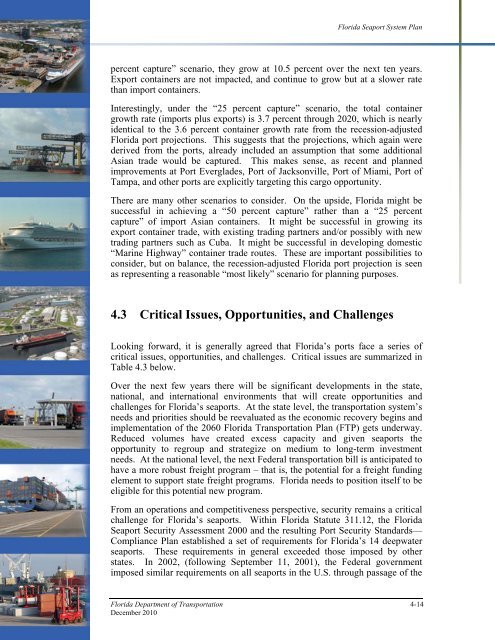Florida Seaport System Plan - SeaCIP
Florida Seaport System Plan - SeaCIP
Florida Seaport System Plan - SeaCIP
You also want an ePaper? Increase the reach of your titles
YUMPU automatically turns print PDFs into web optimized ePapers that Google loves.
<strong>Florida</strong> <strong>Seaport</strong> <strong>System</strong> <strong>Plan</strong><br />
percent capture” scenario, they grow at 10.5 percent over the next ten years.<br />
Export containers are not impacted, and continue to grow but at a slower rate<br />
than import containers.<br />
Interestingly, under the “25 percent capture” scenario, the total container<br />
growth rate (imports plus exports) is 3.7 percent through 2020, which is nearly<br />
identical to the 3.6 percent container growth rate from the recession-adjusted<br />
<strong>Florida</strong> port projections. This suggests that the projections, which again were<br />
derived from the ports, already included an assumption that some additional<br />
Asian trade would be captured. This makes sense, as recent and planned<br />
improvements at Port Everglades, Port of Jacksonville, Port of Miami, Port of<br />
Tampa, and other ports are explicitly targeting this cargo opportunity.<br />
There are many other scenarios to consider. On the upside, <strong>Florida</strong> might be<br />
successful in achieving a “50 percent capture” rather than a “25 percent<br />
capture” of import Asian containers. It might be successful in growing its<br />
export container trade, with existing trading partners and/or possibly with new<br />
trading partners such as Cuba. It might be successful in developing domestic<br />
“Marine Highway” container trade routes. These are important possibilities to<br />
consider, but on balance, the recession-adjusted <strong>Florida</strong> port projection is seen<br />
as representing a reasonable “most likely” scenario for planning purposes.<br />
4.3 Critical Issues, Opportunities, and Challenges<br />
Looking forward, it is generally agreed that <strong>Florida</strong>’s ports face a series of<br />
critical issues, opportunities, and challenges. Critical issues are summarized in<br />
Table 4.3 below.<br />
Over the next few years there will be significant developments in the state,<br />
national, and international environments that will create opportunities and<br />
challenges for <strong>Florida</strong>’s seaports. At the state level, the transportation system’s<br />
needs and priorities should be reevaluated as the economic recovery begins and<br />
implementation of the 2060 <strong>Florida</strong> Transportation <strong>Plan</strong> (FTP) gets underway.<br />
Reduced volumes have created excess capacity and given seaports the<br />
opportunity to regroup and strategize on medium to long-term investment<br />
needs. At the national level, the next Federal transportation bill is anticipated to<br />
have a more robust freight program – that is, the potential for a freight funding<br />
element to support state freight programs. <strong>Florida</strong> needs to position itself to be<br />
eligible for this potential new program.<br />
From an operations and competitiveness perspective, security remains a critical<br />
challenge for <strong>Florida</strong>’s seaports. Within <strong>Florida</strong> Statute 311.12, the <strong>Florida</strong><br />
<strong>Seaport</strong> Security Assessment 2000 and the resulting Port Security Standards—<br />
Compliance <strong>Plan</strong> established a set of requirements for <strong>Florida</strong>’s 14 deepwater<br />
seaports. These requirements in general exceeded those imposed by other<br />
states. In 2002, (following September 11, 2001), the Federal government<br />
imposed similar requirements on all seaports in the U.S. through passage of the<br />
<strong>Florida</strong> Department of Transportation 4-14<br />
December 2010
















